|
It’s the most wonderful time of the year. Rhubarb’s back in town, spindly stalks dressed in spring green and vampy red. Commonly referred to as ‘pie plant,’ the perennial is crowned with a lethal tousle of leaves that have no place beneath a lattice top. Leafy Rhubarb Pie sounds like just the thing one might come across in a dark fairy tale, or under the hands of a short-tempered baker. No need to worry-if there’s one thing I take most seriously, it’s rhubarb leaf removal.
Like any fruit or vegetable limited to a short season, rhubarb pie has a dedicated following. Many of the young barista crew at the bakery are new to the rhubarb experience. Confiding that they have never before tasted rhubarb, they often ask to sample a piece of the raw stalks. Their reactions are reminiscent of middle schoolers experiencing Pop Rocks for the first time. The bakery’s first case of rhubarb arrived this week, direct from a Lancaster County farm fresh cooperative. Rest assured, any threat of wayward toxic leaves wreaking havoc amongst the community has been eliminated under a watchful eye and a sharp paring knife. No longer limited to tucking the tart pie plant between two circles of pate brisee, the short season ingredient is popping up in both sweet and savory recipes at an alarming rate. One might say rhubarb is traveling across the internet with the speed of a unicorn making its way towards a buttercream cake. Highly coveted by those driving the hip and cool recipe bus, rhubarb is currently making a splash in icy cocktails and being tossed on its head in upside down cakes. It has been seen snuggling against fish tacos and swiss chard, duck breasts and asparagus. Call me old-fashioned, but I see nothing wrong in combining a few handfuls of rhubarb with a little sugar and a few strawberries, cooking it down into a quick jam. My mother introduced me to the surprising tartness of rhubarb when I was quite young. She cooked it just long enough to soften the thick slices, adding a generous amount of freckled strawberries and just enough sweetening from the yellow box of Domino sugar. Once it cooled, we ate it with spoons, straight-up, out of small dimpled bowls. I don’t remember anyone else in the house clamoring for a taste. My love of pairing sweet with tart most definitely came from my mother. Good gene pool. A little bit of unforeseen kismet brings Sibling-Formerly-of-Seattle-Currently-of-Toronto into town again this weekend. I couldn’t be happier to have her company, even if she has threatened to reorganize my work wardrobe. A little splash of rhubarb circa 2012 across a once white t-shirt seems perfectly agreeable to me. Knowing that my sister does not share my t-shirt sentimentality, I’ll bury it in the bottom of the dresser and hope she doesn’t find it. With company coming, I have unearthed one of Jessie’s favorite baking pans, the mighty Magnalite, embossed with the clarification that it is a Roast and Bake Pan. Sporting two ridged handles and weightier than my pedestrian 9” by 13” brownie pan, the Magnalite had but one use when Jessie ran the kitchen. It was used to hold tightly coiled spirals of butter-rich sweet dough, busting with raisins and walnuts. Jessie’s Sugar Buns were reserved exclusively for Sunday mornings, filling the house with the fragrance of yeast-risen dough, perfumed with cinnamon and brown sugar. There was no cloying confectioners’ sugar glaze on top, just plump raisins peeking out from a morning pastry that was just sweet enough. Jessie’s recipe for Sugar Buns came from the soft-cover Treasury of Yeast Baking compiled by the folks at Fleishchmann. Her directive for the filling is penned in classic Jessie-speak. “Cinnamon- use your own judgement. Raisins- the green measuring cup.” Thankfully, I speak that language. This week’s recipe combines both Jessie’s Sugar Buns and Rommy’s penchant for rhubarb and strawberries. Unless your baking plans are more homicide-driven than usual, make sure to remove those poisonous rhubarb leaves. Which leads me to wonder, if we can put a unicorn on a cake, why can’t we figure out a way to grow rhubarb year round?
1 Comment
Apparently, one girl’s Seven Layer Magic Cookie is another girl’s Hello, Dolly. I was never one to belly up to the overloaded, multi-layered cookie bar. The onslaught of graham crackers, butterscotch chips, flaked coconut, chocolate and nuts doused in sweetened condensed milk defies cookie overkill. Too sweet for my liking, more confection than cookie, this is clearly something only your dentist might approve in hopes of growing his business.
Sweetened condensed milk is the raison d’etre behind the popular cookie. The toothache-in-a-can was developed by Frenchman Gail Borden in 1820. Distributed amongst field soldiers during the Civil War, it was also marketed as an ideal baby formula in the mid-1850s because it didn’t require refrigeration. With the advent of refrigeration, the pantry staple needed a new image. In the 1960s, Borden Kitchens sought inspired ideas using sweetened condensed milk, paying a whopping $25 for original recipes. The Seven Layer Magic Cookie Bar recipe emblazoned on the red-labeled cans might be a hybrid of more than one recipe. I am less interested in baking and consuming the pop-culture cookie, more interested in how the multi-layered bar cookie inherited its stage name, Hello, Dollys. Both cake and cookie recipes bearing the name Hello, Dolly were published in 1965, one in a recipe swap column in a Syracuse, NY paper, another in an Oklahoma newspaper. Is it merely coincidence that a certain musical was playing on Broadway at the time these recipes were introduced? Add to the mix the fact that said musical had just won a record breaking 10 Tony awards and I suspect not. There is no mention of graham crackers or sweetened condensed milk during Dolly Levi’s lavish dinner at the Harmonia Gardens in Act II of Hello, Dolly. Tuxedoed waiters leap across the stage bearing trays of Charlotte Russe, a gravitational wonder composed of Bavarian cream wrapped in ladyfingers. What is the key ingredient for a gelatin-based dessert playing 8 performances a week, illuminated by screaming hot lights? Plenty of stage magic. There are many who believe a recipe dedicated to sweets congealed by sweetened condensed milk is worthy of a standing ovation. My co-worker Adam, for instance is a big fan of the bar cookie and the milk that holds it together. Part-time baker, soon-to-be full time research chemist. Adam is the only individual in the bakery with chiseled features worthy of an 8x10 glossy photo. Adam graciously let me borrow his well-loved cookbook, Cookinanny, a compilation of recipes from the B’nai Zion Sisterhood of Shreveport, Louisiana. His grandmother, Sylvia was at the helm of the project, a soft covered book held together with a red spiral binding. The lovely Freida Bauer contributed her recipe for Graham Cracker Squares, closely akin to the 7 Layer Bar and featuring Eagle Brand Milk. The beauty of this cookbook, published in 1964, is the sense of community you get within each recipe. The ladies of the B’nai Zion Sisterhood were not shy when affixing titles to their recipes; adjectives such as “glorious,” “yummy,” and “heavenly” pepper the pages, providing a distinctive voice to the collection. I was sad to note that despite its southern roots, the cookbook offered nary a rhubarb recipe. The Rich Poppy Seed Cake with Yummy Filling did pique my interest, but will have to wait a week. The arrival of my favorite tart-tongued ingredient has me quietly obsessing over potential pies, tarts and yeast-risen breads. A plant clearly more Dolly Levi than Marian the Librarian rejoins me in the kitchen. The commonplace name for spring's leading lady may be Pie Plant, her stage name, Rhubarb but I’m happy to call her Barb for short. Incidentally, I just happen to know someone named Barb who will enjoy this week's recipe. As vivid as Dolly Levi’s red sequins and feathers, rhubarb has already stained my fingertips crimson. I am not complaining. Removing a bit of the outer peel with a Y-shaped vegetable peeler, the rhubarb curls like ribbons on a beautifully made hat. Well Hello, Rhubarb. It’s so nice to have you back where you belong. I hope the Easter Bunny isn’t bumped from his overbooked flight. It’s bad enough he’ll be forced to check his basket at the gate. An innocent carry-on filled with artificial grass, neon Peeps, jellybeans, plus the occasional Cadbury egg has no place tumbling down a tired conveyor belt at baggage claim.
Due to a bout of post-traumatic Passover Macaroon Syndrome, I am staying close to home this holiday weekend. I am also adhering to a strict coconut-free diet for the foreseeable future. That means just saying no to the 10 oz. cello package of Manishewitz toasted coconut marshmallows that happen to be on sale at Stop and Shop. That also includes pushing the open bag of Angel Flake coconut to the rear of the kitchen cabinet, rummaging instead for a small container of candied fruit peels. Seeking out supermarkets and green markets in foreign countries is a passion of mine, combing the aisles for hard-to-find ingredients, earmarking them for particular holidays. The purchase of a few packages of candied frutta from Italy and a wedge of citron secured from a London green market hardly seems like a criminal act. ‘Smuggled through customs’ has such a harsh ring to it. Claiming to have a fruit and nut aisle in my kitchen pantry is somewhat of an exaggeration, but not far from the truth. Nutmeats, dried fruits and an obscene variety of candied and crystallized ginger fight for shelving space. Dried cherries and Turkish apricots have gone head-to-head with sugared pineapple and plump figs. Miniature chocolate chips elbow semi-sweet chunks and blocks of bittersweet studded with almonds. Each time the cabinet doors are flung open, another item is sent plunging to the floor. Despite years of pondering kitchen storage solutions as offered by a southern Swedish retailer, I continue to falter. Plucking 70 grams of Italian candied fruit peels from the top shelf frees up highly desirable cabinet space. An open package of Oregon hazelnuts finally has room to breathe, but not before taking a dive, spilling like tiny pebbles around my sneakered feet. Sweeping them into a dustpan, I reconsider the IKEA catalog buried beneath an unopened 25 lb. bag of sugar. A quick glance indicating it is best to consumarsi preferibilmente entro il 25-06-2017 assures me it is safe to peel back the wrappings on the candied fruit. Turning the jeweled fruits into a generous splash of Limoncello, I empty a container of whole milk ricotta into a fine mesh strainer lined with cheesecloth. What is that sound? Nothing but the rumblings of low-density lipoproteins pulsing through my arteries. Whole milk ricotta is commonly used when making cannoli filling. Many years back, one of my tasks at a Bucks County farm bakery was to prepare the filling for cannolis. We used Ricotta Impastata; a slightly tangy cheese with a silken texture, drier than pedestrian ricotta, and a perfect pairing with chocolate chips and candied fruit. Good quality impastata is Sicilian in origin and pretty pricey. Many commercial bakeries use what is known as Bakers Cheese, drier than cottage cheese, similar to farmer’s-cheese, tangy in flavor, smooth in texture. Ricotta cheese and mascarpone is also popular among pastry chefs, providing a slightly more stable, pipeable filling. How convenient that the recipe I’m making this week calls for 2½ pounds of ricotta cheese and Trader Joe’s prefers to sell 1 pound tubs. While I’m here, I’ll pick up a package of hazelnuts. Turning the drained ricotta into a red Pyrex mixing bowl, the addition of vanilla, lemon, orange, anise and slightly tipsy fruit peel creates a fragrance reminiscent of both a Bucks County farm kitchen and an Italian pasticceria. A handful of crushed hazelnuts, dark chocolate and almost-orange egg yolks are folded into the mixture. The filling will sit between a top and bottom crust known as pasta frolla, roughly translated as tender dough. Baked at a low heat for a long time provides ample opportunity for leafing through pantry strategies in the Sektion System of a certain weighty catalogue. Sibling Sister Recently of Toronto breezes through town next week. A light traveler by nature, I imagine she will arrive armed with little more than a small carry-on. Barring any brush with Customs, I will be more than happy to assist her with her belongings. Particularly since she informs me that her new digs are but a jellybean’s throw from Toronto’s Cadbury Chocolate Factory. Who am I to criticize a week-old chocolate bunny and a Dairy Milk creme egg? Easter has clearly taken the lead in the holiday cookie marathon with Macaroon trailing Bunny by more than a pink icing nose. Sequestered on my little macaroon island, the air circling my workspace is intoxicatingly sweet, equal parts shredded coconut to big flake desiccated coconut, with a generous hit of vanilla.
The month of April slipped into town last week, crocuses and daffodils searching for a place in the sun. Overshadowed by gray skies and chilly temps, the landscape beyond the bakery window gives little indication as to the season. Thank goodness for expiration dates on cases of dairy stacked high in the walk-in refrigerator. The retail public also helps clarify the upcoming holidays with persistent inquiries. “No, the macaroons are not made with flour. And no, we are not a Kosher bakery. And yes, there is dairy in the flourless chocolate cake, but no, no gluten. And yes, the flourless pecan torte has no flour but yes, it has pecans. Yes, if you have a nut allergy then no, I wouldn’t advise it.” You can bet your chocolate peanut butter egg that by the time I sit down to my Passover dinner, I will be more than ready for a glass of wine; perhaps two. Not wishing to take sides, clearly the Easter cookies seem to get a pass. Bunny cookies cooling their freshly sugared tails never encounter an interrogation. Passover macaroons seldom escape unscathed. A young woman stopped me yesterday as I returned a stray Sharpie marker to a cup adjacent to the telephone. “Is it too late to order macaroons for Passover?” The hairspray from her freshly layered bob cut through the air like a chef’s knife. I stifled a pertussive cough as she glanced down at her phone, then up to the chalkboard menu hanging overhead. I waited, she continued. “What are the chocolate macaroons? Are they plain with chocolate, or just chocolate? Lemon macaroons? What are those? Are they in the same box?!” She seemed horrified. Is an assorted box of macaroons so hard to understand? No one questions the boxes of sugar drenched bunnies on the run. Folks scoop up cello wrapped baskets of assorted Easter themed cookies without a fuss. Why must the macaroon be subject to criticism and debate? Not even a Passover Haggadah can shed light on the history of the macaroon. Trust me when I tell you that airtight canisters of dry, coconut spiked cookies did not simply appear on supermarket shelves. Like many food traditions, they evolved over time. Macaroons (not to be confused with the French macaron) have a history that dates back to the 13th century. Long before coconut was available to European bakers, macaroons were made with egg whites, sugar and either almond paste, marzipan or nutmeats. Tunisians introduced Sicilians to the flourless cookies, enhanced with almonds. Macaroons became popular within the Italian Jewish communities, not only during Passover but year round. When Eastern European Jews immigrated to the United States, recipes for cookies featuring egg whites, sugar and nuts followed. Sephardic cookbooks feature macaroon recipes using strictly ground nuts, not coconut. The addition of coconut can loosely be credited to Philadelphia flour miller, Franklin Baker. In 1895, Baker exported a shipment of flour to Cuba and was paid in fresh coconuts. Sensing a need in the baking community for dried coconut, Baker ultimately sold his flour business in order to concentrate on coconut. His inkling proved enormously profitable. The business eventually became the Franklin Baker Company, specializing in desiccated (dried) coconut products. The introduction of dried coconut changed macaroons forever. This bit of food history is of little interest to the macaroon-seeking patrons at my workplace. They are more concerned that lemon-filled macaroons, plain macaroons and their chocolate drizzled counterparts have plenty of elbow room. Sorry, but there’s just so much space in a 6” square window bakery box. As for the lemon macaroon naysayers, the pairing of sweet coconut and tart lemon is as perfectly matched as dark chocolate and coconut. Which brings me to this week’s recipe, Lemon Pie with Toasty Meringue and Macaroon Crust. Filling a pie plate with an oversized macaroon and filling it with tart lemon curd can only be enhanced with a drizzle of dark chocolate. A nibble of a chocolate dipped macaroon alongside a slice of bright lemon topped with marshmallow almost redeems this week’s retail holiday. Almost. |
Archives
July 2024
Ellen GrayProfessional Pie-isms & Seasonal Sarcasm Categories |
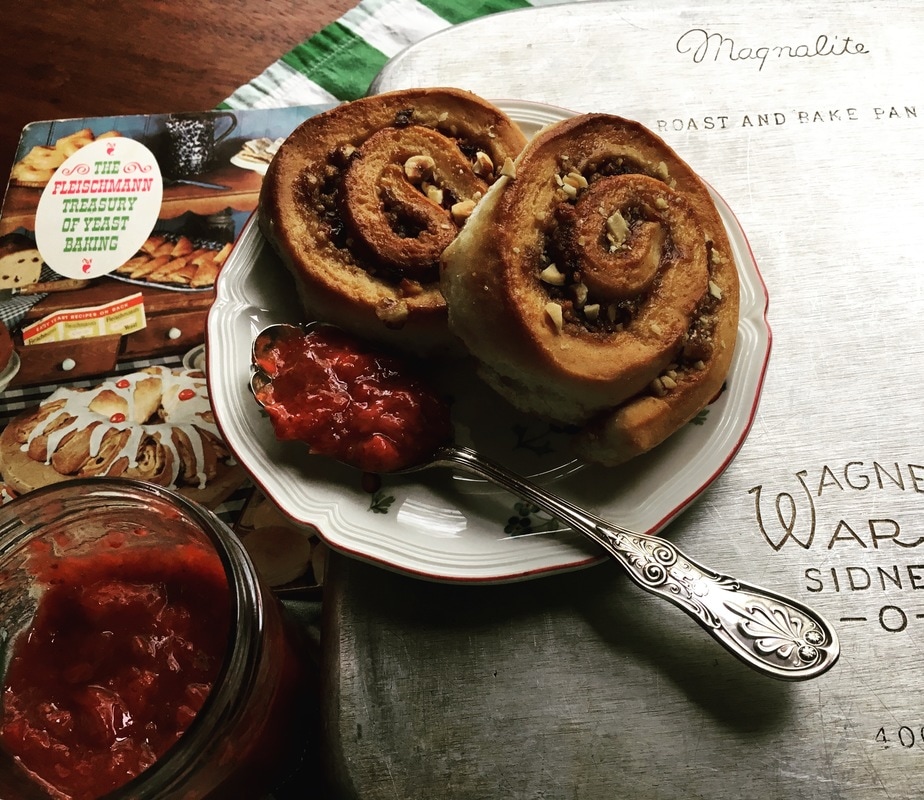
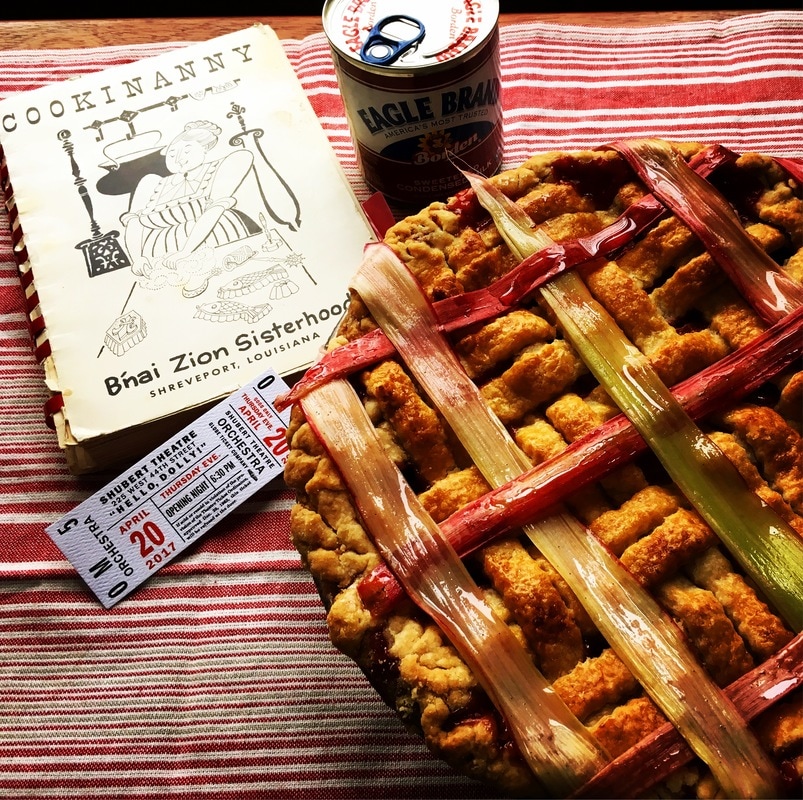
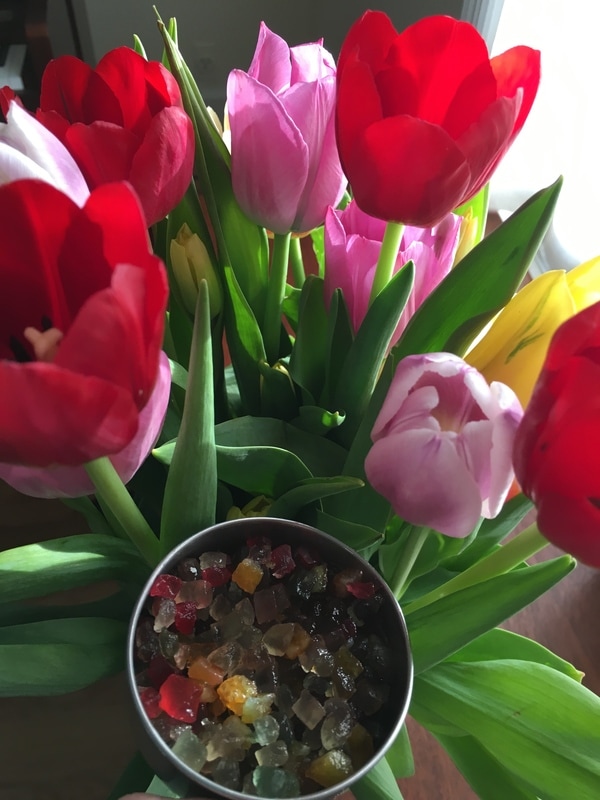

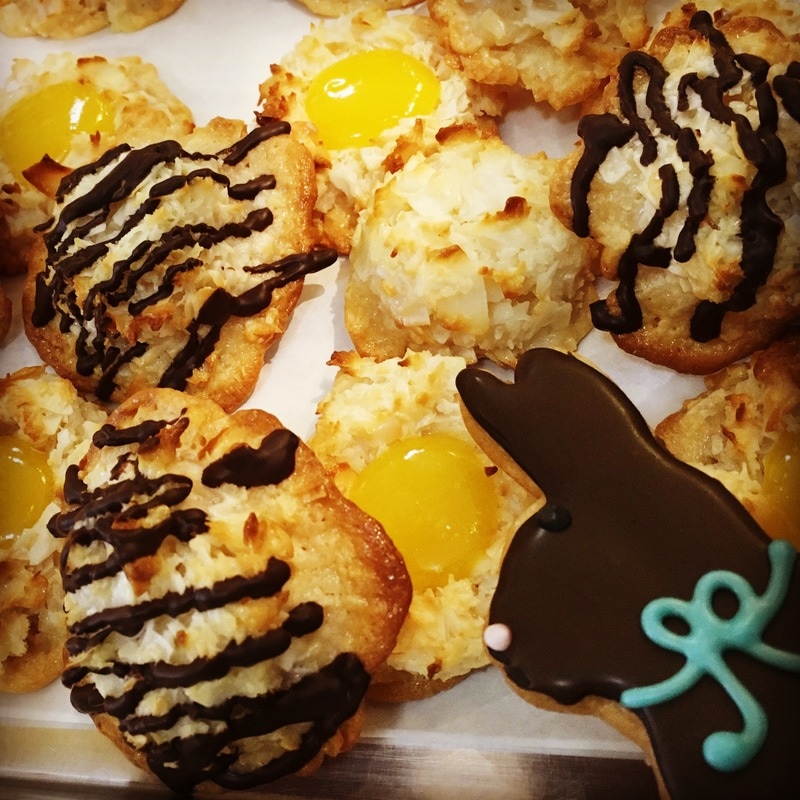
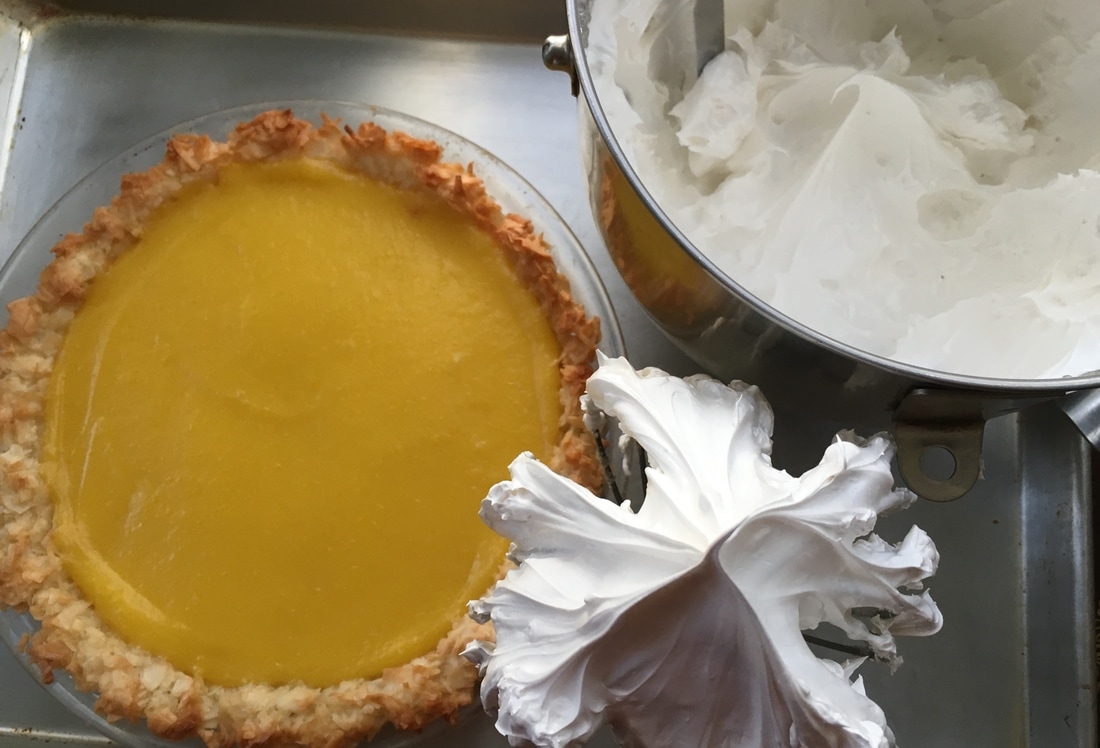
 RSS Feed
RSS Feed